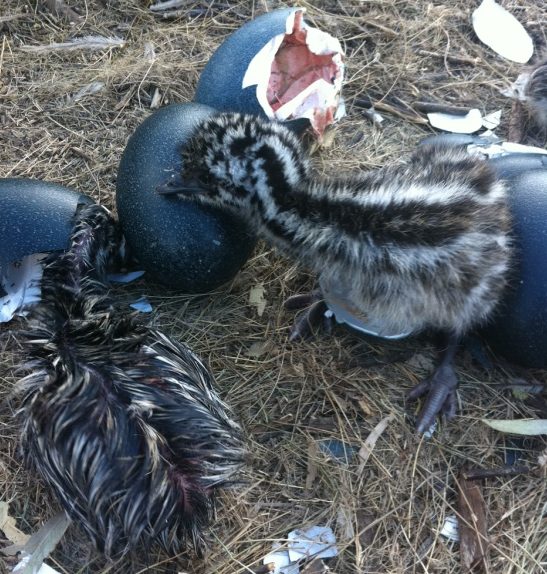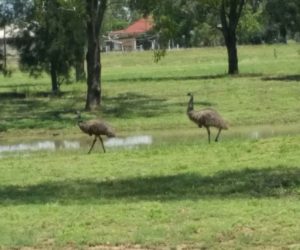
Hi I’m Meryl. I had a tourism planning meeting in Roma, Queensland a couple of weeks back. When I came outside of the Visitor Information Centre at around 1pm and found these two tourists enjoying the rain. 
It is not often we get emus in the middle of town, and when we do they are usually low in numbers. Occasionally they move through our farm located halfway between Roma and Injune, however again I’ve ever only see a couple of birds there at any one time over the last twenty years. Maybe that’s because we don’t crop on this property? We often see a lot more birds around when driving past cropped paddocks in the region, as they are quite partial to the seed being grown.
Emus are more common in Western Queensland, however are highly nomadic, moving east during dry periods in search of food. There are a couple of areas where you can still see them along the Eastern coastline of Queensland, however not many. The best place to see them in their natural habitat is Outback Queensland.
A beautiful angelic bird, I can’t tell if these are male or female from this distance. They usually breed in response to rain, so maybe they are one of each. After laying the eggs, the female takes off and leaves the male to sit on the eggs, as well as raise the young. The adult males are generally very protective of their young, so we advise you not to get too close. Catching an emu can also be quite a tricky business. Watch out as they generally strike their feet (with sharp claws) forward. Approaching them from the back is a lot safer. We’ve only ever had to do this a couple of times to help remove an emu from enclosed quarters in a public space in the middle of town.
Young emus are striped helping them to camouflage themselves amongst the grass. We are lucky enough to have a photo of some hatching in the wild….check it out above.
Emus eat just about anything including fruit, seeds, mice, lizards, grass and herbage.
Driving in Outback Queensland you need to be careful of emus, as they can do some damage to your vehicle if you hit them. When they’re hit, with their long legs it is not uncommon for them to roll over the bonnet. So when driving in the Outback take care, drive to the conditions and keep an eye out for our native wildlife. They too want to be able to get back with their family.
by Meryl Eddie, Business Manager, Boobook Explore

